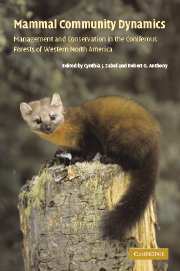 Mammal Community Dynamics
Mammal Community Dynamics Book contents
- Frontmatter
- Contents
- List of contributors
- Foreword
- Acknowledgments
- Part I Management and conservation issues for various taxa
- Part II Community and ecosystem relations
- 10 Relationships among fungi and small mammals in forested ecosystems
- 11 Ecology of coarse woody debris and its role as habitat for mammals
- 12 The ecological role of tree-dwelling mammals in western coniferous forests
- 13 The role of ungulates and large predators on plant communities and ecosystem processes in western national parks
- 14 The role of the lynx–hare cycle in boreal forest community dynamics
- 15 Associations of mammals with riparian ecosystems in Pacific Northwest forests
- Part III Conservation issues and strategies
- Index
- References
14 - The role of the lynx–hare cycle in boreal forest community dynamics
Published online by Cambridge University Press: 15 December 2009
- Frontmatter
- Contents
- List of contributors
- Foreword
- Acknowledgments
- Part I Management and conservation issues for various taxa
- Part II Community and ecosystem relations
- 10 Relationships among fungi and small mammals in forested ecosystems
- 11 Ecology of coarse woody debris and its role as habitat for mammals
- 12 The ecological role of tree-dwelling mammals in western coniferous forests
- 13 The role of ungulates and large predators on plant communities and ecosystem processes in western national parks
- 14 The role of the lynx–hare cycle in boreal forest community dynamics
- 15 Associations of mammals with riparian ecosystems in Pacific Northwest forests
- Part III Conservation issues and strategies
- Index
- References
Summary
Snowshoe hare (Lepus americanus) and lynx (Lynx canadensis) populations show 9- to 11-year cycles throughout the boreal coniferous forests of Canada and Alaska. Lynx cycles, recorded in Hudson Bay trapping records covering many decades, have been analyzed by population ecologists interested in understanding the mechanisms underlying the cycle (Royama 1992, Ranta et al. 1997). Long-term records of hare cycles are less common but there have been two major field programs that have measured demographic changes over at least one full cycle. This includes the work based at Rochester, Alberta by Lloyd Keith and co-workers (Keith et al. 1984, Keith 1990) and our work based at Kluane, Yukon (Krebs et al. 1986, Sinclair et al. 1988, Krebs et al. 1995). These field studies have established the demographic mechanisms that drive changes in hare numbers and have tested mechanistic hypotheses about factors that stop population increase and cause the hare population decline (Keith 1990, Krebs et al. 2001b).
It is clear that the lynx and hare are tightly linked (Royama 1992, Stenseth et al. 1998). Lynx show strong functional and numerical responses to changes in hare density (Keith et al. 1977, O'Donoghue et al. 1998). In turn, the dominant proximate cause of hare mortality is predation (Keith et al. 1984, Boutin et al. 1986) with lynx being one of a suite of hare predators.
- Type
- Chapter
- Information
- Mammal Community DynamicsManagement and Conservation in the Coniferous Forests of Western North America, pp. 487 - 509Publisher: Cambridge University PressPrint publication year: 2003
References
- 4
- Cited by


